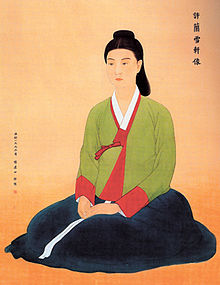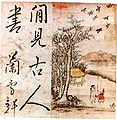Heo Chohui
| Korean spelling | |
|---|---|
| Hangeul | 허 초희 |
| Hanja | 許 楚 姬 |
|
Revised Romanization |
Heo Chohui |
|
McCune- Reischauer |
Hŏ Ch'ohŭi |
| stage name | |
| Hangeul | 허난설헌 |
| Hanja | 許 蘭 雪 軒 |
|
Revised Romanization |
Heo Nanseolheon |
|
McCune- Reischauer |
Hŏ Nansŏrhŏn |
| Another stage name | |
| Hangeul | 난 설재 |
| Hanja | 蘭 雪 齋 |
|
Revised Romanization |
Nanseoljae |
Heo Chohui (* 1563 in Gangneung ; † March 19, 1589 ) was a Korean poet and writer, painter and artist, during the Joseon Dynasty . Her stage name was Nanseolheon ( 난설헌, 蘭 雪 軒 ) and Nanseoljae ( 난 설재, 蘭 雪 齋 ). She wrote several hundred poems in Chinese characters and a traditional Chinese style, but only a portion of them have survived.
biography
family
Heo Chohui Gangneung was born as the daughter of Heo Yeop (Hangeul: 허엽 ) and his 2nd wife (only the family name Kim (Hangeul: 김 ) has been passed down from her ). Her father was a respected scholar and politician who belonged to the Yangban class and held a very conservative Confucian worldview, particularly the principle of namjon-yubi (men above, women below). In his first marriage he was married to the daughter of Prince Seop'yeong , from this marriage had two daughters and a son. His second wife was the daughter of a minister. From this marriage Chohui , her older brother Heo Pong and her younger Heo Gyun (1569-1618) emerged.
Childhood and youth
The father thought that education for girls was superfluous. However, Chohui's older brother Pong recognized her talents and curiosity. He taught her to read and write and familiarized her with literature. Later, according to their inclinations, he brought them into contact with writers and artists of their time. She quickly attracted attention with her pronounced talent for poetry, even if, as a woman, she was denied a real social career based on it. Her early poem "Inscriptions in the roof beam of the White Jade Pavilion in the Kwanghan Palace" ("Kwanghanjeon Paegongnu sangnangmun"), which she is said to have written at the age of 8, was praised as a masterpiece of poetry. Her talent for Hanmun , a form of Chinese poetry, also prompted her brother Heo Pong to teach her Chinese characters at an early age and to introduce her to the Five Classics of Confucius .
Nevertheless, Heo Pong had a pronounced critical stance on Confucianism and its interpretation in his time. He was therefore finally exiled to Kapsan ( 갑산 군 ) for three years . Chohui's younger brother Heo Gyun , who had a similar talent for poetry, and his teacher Yi Dal李 達 a friend of Heo Pong, now took on the task of promoting Heo Chohui and enabling her to establish contacts in literary circles that would otherwise not be possible for her as a woman would have been. The influence of Yi Dal on Chohui can be traced in the poems that have been preserved from her.
marriage
From surviving records of her brother Heo Gyun it is known that Heo Chohui married the son of an official, Kim Seongnip. The time and details of this marriage are not known. However, as Heo Gyun's notes also indicate, the marriage was not a happy one. Her husband is said to have cheated regularly, and the self-confident demeanor and unconventional views of Heo Chohui were also a thorn in the side of the mother-in-law. She had two children, a boy and a girl. The children died very young for consecutive years. After her older brother Heo Pong died in exile shortly afterwards, Heo Chohui died within a year on March 19, 1589, at the age of 27.
Your time
In the early Joseon period, especially in the political Sajang School and the more academic Sallim School, literature was heavily influenced by the Confucian and Neo-Confucian literary traditions. That is, literature served primarily to convey Confucian moral teaching. This also applied to poetry. The main purpose of the poem was to make it easier to remember a text in order to reach those parts of the population who could not read. Poetry was part of the official exams. Poems followed strict rules.
At the time of Heo Chohuis, however, it became more and more fashionable to break away from these strict rules; Heo Chohui was part of it. Her poems stand out in particular because of their wide range of topics, among other things caused by the strong change in their mood after their marriage and the exile of their older brother.
Act
Much of her poems were burned after her death at her own request. The surviving writings were brought together in Heo Kyeongnan's collection Nansŏrhŏn chip from 1913. The collection contains 211 poems in various Chinese styles. What is striking about the poems that have survived is that some of the poems are written in the Chinese Tang style , describe the beauty of nature, contain folk motifs and express a cheerful, optimistic mood; another part is about the hardships and sufferings of a married woman. Researchers like Kim-Renaud and Choe-Wall , who studied her writings, suggested that she lived with her brothers for a long time and got married late. Since the poems are not dated, they suspect that the former coincided with the time when she lived with her brothers and was encouraged by them, while the latter were written after her marriage or her brother's exile. However, there are no reliable sources for this.
Two poems written in Hangeul , (the Korean alphabet) are also sometimes ascribed to her, but this assignment is controversial. At that time, Hangeul was not considered worthy of a higher-ranking family.
In addition to her poems, Heo Chohui is also known for her paintings.
Selection of poems
The poem "Song in an Autumn Night" is her early imaginative pictorial creative phase. It is a seven-syllable cheolgu .
秋夜 曲
蟪 蛄 切切 風 瀟瀟
芙蓉 香 褪 永 輪 高
佳人 手把 金 錯 刀
挑燈 永夜 縫 征 袍
玉 漏 微微 燈 耿耿
耿耿 罹 幃 寒 逼 逼 秋 宵 永
邊 衣 裁 罷 剪刀 冷
滿 窓 風 動 芭蕉 影
Heo Nanheoseon,
original Chinese.
After Kuiwon
Song of an autumn night
The locusts are serious and soulful; the wind is pure and clear.
The scent of the lotus disappears; above me the eternal wheel.
The hand of a beautiful woman reaches for a gold-plated coin;
She lights the wick of a lamp and sews on a man's garment until late at night.
The water clock is cloudy and cloudy; the lamp shines brightly.
The cold creeps into the holey tent and the autumn night never ends.
The clothes have dried on the fence; the scissors have cooled down.
On the window, the shadows of the branches of a tree play as the wind moves.
Heo Nanheoseon,
translated into English by Kuiwon, German translation from English
“The young seamstress”, or “Song for a poor girl”, is one of her poems in which she takes an interest in poorer sections of the population. It's a five-syllable cheolgu .
貧 女 吟
豈 是 乏 容色
工 鍼 復工 織
少小 長 寒門
良 媒 不 相識
夜 久 織 未 休
戛戛 鳴 鳴 寒 機
機 中 一 匹練 匹練
終 作 阿 誰 衣
手把 金 翦 刀
夜寒 十指 直
爲人作嫁衣
年年 還 獨 宿
Heo Nanheoseon,
Original Chinese.
The young seamstress
How can this exhausted face radiate charm?
Work on an embroidery, then back to the loom.
Behind a gate where there is little, almost nothing, and no more warmth for a long time.
The matchmaker steers clear of such poverty.
All night long, without a break, the hemp is woven,
the loom goes clack-clack, clack-clack, the sound makes you shiver.
Weave a bale of fabric on a loom and ask:
for which family, which daughter will the wedding dress be sewn from it?
Scissors in hand, cut the fabric into pieces;
and although the night is cold, all ten fingers are still straight.
I do each other's wedding wardrobe,
and I have to sleep alone year after year.
Heo Nanheoseon,
translated into English by Kuiwon, German translation from English
"Lament of a woman", another seven-syllable cheolgu , represents a creative phase which is believed to have originated after her marriage and after the exile of her older brother Heo Pong.
閨怨
錦帶 羅裙 積 淚痕
一年 芳草 恨 王孫
瑤 箏 彈 盡 江南 曲
雨打 梨花 晝 掩門
月 樓 秋 盡 玉 屛 屛 空
霜打 蘆洲 下 暮 鴻
瑤瑟 一 彈 人 不見
藕花 零落 野塘 中
Heo Nanheoseon,
Original Chinese
A woman's lament
The embroidered sash and the silk dress are soaked with tears,
Every year fragrant plants lament a princely friend.
On my lute I play the song from the south river to the end;
Showers of peach blossoms rain on the door, which is locked all day.
Autumn has passed; the moon shines on the pavilion; his jade discs bleak.
Hoar frost encrusts the reed island; Wild geese rest for the night.
I play the lute on the jasper. Nobody notices me.
Lotus leaves fall into the pond.
Heo Nanheoseon,
translated into English by Yang-hi Cheo-Wall, German translation from English.
Collections
- Nanseolheon jip
- Chwesawonchang
photos
literature
- Vision of a Phoenix: the Poems of Hŏ Nansŏrhŏn . 2003, ISBN 1-885445-17-2 .
- Jaihiun Joyce Kim: Classical Korean Poetry . 1986, OCLC 614931156 .
- Peter H. Lee: Anthology of Korean Literature: from Early Times to the Nineteenth Century . 1981, ISBN 0-8248-0756-1 .
- Peter H. Lee: The Columbia Anthology of Traditional Korean Poetry . Columbia University Press, 2002, ISBN 0-231-11113-4 .
- David R. McCann: Early Korean Literature: Selections and Introductions . 2000, ISBN 0-231-11947-X .
- David R. McCann: Form and Freedom in Korean Poetry . Brill, 1988, ISBN 90-04-08548-3 .
Web links
- Kuiwon. Retrieved July 9, 2014 .
- In memory of the Heo siblings. (No longer available online.) HONGKILDONG.OR.KR, 2008, formerly in the original ; Retrieved July 9, 2014 (Korean). ( Page no longer available , search in web archives )
Individual evidence
- ↑ a b c d e f g h Y. Choe-Wall, N. Heo (Ed.): Vision of a Phoenix: the Poems of Hŏ Nansŏrhŏn (= Cornell East Asia series ). Ithaca, New York 2003, ISBN 1-885445-17-2 .
- ^ A b c Kim-Renaud, Young-Key: Creative Women of Korea: the Fifteenth through the Twentieth Centuries . 2004, ISBN 0-7656-1188-0 .
- ↑ Heo Gyun and Heo Nanseolheon. (No longer available online.) PR Korea Times, Sep 29, 2005, archived from the original on June 10, 2011 ; Retrieved October 6, 2008 . Info: The archive link was inserted automatically and has not yet been checked. Please check the original and archive link according to the instructions and then remove this notice.
- ↑ a b c ( page no longer available , search in web archives: kuiwon.wordpress )
| personal data | |
|---|---|
| SURNAME | Hey, Chohui |
| ALTERNATIVE NAMES | 허 초희 (Korean); 許 楚 姬 (Hanja); Nanseolheon; 난설헌 蘭 雪 軒; Nanseoljae; 난 설재 蘭 雪 齋 |
| BRIEF DESCRIPTION | Korean poet, painter, writer |
| DATE OF BIRTH | 1563 |
| PLACE OF BIRTH | Gangneung , Gangwon Province , Korea |
| DATE OF DEATH | March 19, 1589 |





